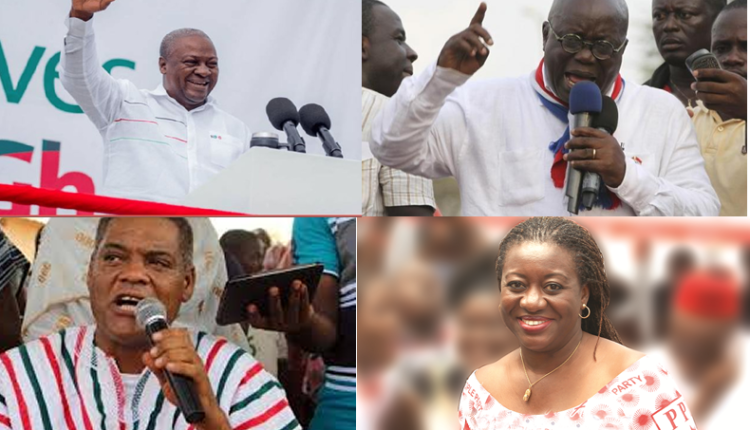New research predicts run-off in December 7 polls
A research conducted by the Governance Research Bureau is projecting a run-off in the 2020 polls.
According to the research, no candidate will win the December 7 polls in the first round.
The result is in contrast to the findings of three surveys conducted by different entities which predicted a win for the New Patriotic Party (NPP) presidential candidate, President Nana Akufo-Addo, in the 2020 elections.
According to the research that was conducted based on an analysis of EC certified results since 1992 and the 2020 Voters Register, “the NPP’s Nana Akufo-Addo will poll 49.19%(8,389,273 votes) with NDC’s John Mahama taking 48.27% (8,233,881 votes) while the others make do with 2.54% (433,257 votes).”
The model used in the survey predicts that the bulk of President Akufo-Addo’s votes will come from the Western, Ahafo, Bono, Ashanti, and Eastern Regions with a performance rating of 53.45%, 52.83%, 56.18%, 72.40%, and 56.97% respectively.
Mr Mahama is expected to win the Western North, Volta, Oti, Upper West, Upper East, Northern, North East, Savannah and Bono East regions are projected to give him 60.16 per cent, 90.39 per cent, 66.97 per cent, 61.33 per cent, 62.55 per cent, 59.28 per cent, 49.07 per cent, 61.88 per cent and 56.59 per cent of the votes respectively.
History of run-offs in Ghana
In Ghana’s electoral history, there have been run-offs twice—2000, which former President John Agyekum Kufuor won, beating the late J.E.A Mills and in 2008 which the late J.E.A Mills won, beating Nana Akufo-Addo.
In the first round of the 2008 elections, Nana Akufo-Addo garnered 49.326% followed by J.E.A Mills at 47.76%.
The results, however, flipped in favour of Prof Mills in the run-off where Mill had 50.23 against Mr Akufo-Addo’s 49.77%.
In the case of the 2000 elections, Mr Kufuor scored 48.40% in the first round and Mills 44.80.
Mr Kufuor stretched his lead in the second round where he got 56.90% and 43.10% for Prof Mills.


Model used
A statement issued by the Bureau signed by Mohammed Affum, its Coordinator, said the statistical tool used for the prediction was the Generalised Linear Model whose dependent variable is the percentage of votes likely to be obtained by the parties with the independent variables being the constituency and parties.
According to the Bureau, its model “operates on the principle that for presidential candidates to win, they should increase their average votes in their respective strongholds while they maintain average or above-average performance in their opponent’s strongholds.”
In addition, they should go beyond their average performance in the swing regions of Greater Accra and Central regions, otherwise, an average performance in their strongholds, as well as their opponent’s strongholds and swing regions, takes the election to the second round while below-average performance signals defeat, it explained.
“While our model relies solely on analysis of quantitative data to reach its conclusions, and these are measurable, we concede that qualitative variables in the constituencies and at the national level may alter the results predicted,” the Bureau observed, adding that the results from the model should be regarded as a guide for political actors.
Other findings
The release further said the standard errors that emerged were 0.76 per cent of the percentage of votes that NPP obtained, 0.75 per cent for NDC and 0.32 per cent for the other parties.
It also said a 95 per cent confidence interval estimate for the percentage of votes for the NPP has a lower limit of 47.69 per cent (8,134,646 votes) and upper limit of 50.68 per cent (8,646,900 votes).
“The NDC has a lower limit of 46.80 per cent (7,983,123 votes) and upper limit of 49.74 per cent (8,484,639 votes) while the other parties have a lower limit of 1.92 per cent (326,964 votes) and an upper limit of 3.16 per cent (539,550 votes).”
It further estimated that in the swing regions of Greater Accra and Central respectively, the NPP would gain 49.75 per cent and 50.16 per cent and the NDC, 49.42 per cent and 47.08 per cent.
With regards to the parliamentary elections, the Governance Research Bureau predicts that the NPP will win 107 seats with the NDC taking 112 while 56 can go either way according to the model.
The 56 constituencies are the following:
Bono: Tain.
Bono East: Nkoranza South and Pru West.
Central: Agona East, Agona West, Ajumako Enyan Essiam, Asikuma Odoben Brakwa, Awutu Senya West, Cape Coast North, Effutu, Gomoa East, Gomoa West, KEEA, Mfantseman and Twifu Ati Morkwa.
Eastern: Akwatia, Abirem North and Suhum.
Greater Accra: Ablekuma Central, Ablekuma South, Bortianor Ingleshie, Korle Klottey, Krowor, Ledzokuku, Madina and Okaikwei North.
Northern: Bimbilla, Kpandai, Mion, Tatale Sanguli, Wulensi and Yendi.
North East: Bunkpurugu, Chereponi, Nalerigu, Walewale.
Savannah: Salaga South.
Oti: Akan, Krachi West, Krachi Nchumuru, Nkwanta North.
Upper East: Builsa South, Navrongo Central, Talensi, Tempane and Zebilla.
Upper West: Sissala East and Sissala West.
Western: Ellembelle, Evalue Gwira, Jomoro, Mpohor, Mpohor Wassa East, Prestea Huni Valley, Shama and Tarkwa-Nsuaem.
This story was written with additional files from Adomonline




See this demonic force news